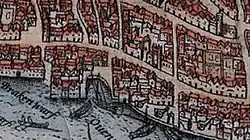
Whittington's Longhouse (or Whittington's Longhouse and Almshouse) was a public toilet in Cheapside,[1] London, constructed with money given or bequeathed by Richard Whittington, Lord Mayor of London. The toilet had 128 seats: 64 for men and 64 for women. It operated from around 1 May 1421,[2] until the seventeenth century.[3]
The Longhouse, though it was not London's first public toilet, was the first public toilet in the capital with separate provision for the sexes.[4]
The Longhouse, and the similarly financed almshouse for five[5] or six parishioners constructed above it, was built by the parish of St Martin Vintry, on a long dock over the Thames.[4] It was on Walbrook Street, at the time an actual brook,[6] approximately where the modern Bell Wharf Lane is,[7] and was "flushed by the Thames".[6] The waste was deposited in a gully which was washed by the tides twice a day – the Thames being tidal there.[8]
Rexroth in his 2007 book Deviance and Power in Late Medieval London argues that with the construction of the almshouse above the privies: "pauperes were assigned new households" where shame had been banished (due to the gender segregation).[4] By the seventeenth century the almshouse was being let on a commercial basis,[7] possibly even as warehousing.[9]
The Longhouse was destroyed in the Great Fire of London and rebuilt on a more modest scale.[9] The new building had six male and six female seats, and, apart from a period where the lessees kept it locked, continued in use until at least 1851, as it is mentioned in an 80-year lease that commenced that year. In a 1935 lease, however, no mention is made, and it is assumed the facilities were by that time closed.[10] After the Second World War, the site was rebuilt in 1953 as part of "Redevelopment unit number 10".[10] There is, however, as of 2015, a Bell Wharf Lane public toilet.
The Longhouse and the other gifts to London, notably improvements to the water supply and a more substantial almshouse as well as schools and hospitals, are credited with raising the profile of Dick Whittington among Londoners, and for leading to the legends that surround his name.[1] Longhouse became a byword for privy, presumably derived from Whittington's Longhouse.[10]
References
- 1 2 Mark Ravenhill (28 November 2006). "Confessions of a panto-lover". The Guardian. Archived from the original on 28 January 2015. Retrieved 24 January 2015.
- ↑ Peter de Loriol (2013). The London Book of Days. The History Press. p. May 1st. ISBN 9780752492438.
- ↑ Mary Anne Case. Why not abolish the laws of urinary segregation? (PDF). Harvey Molotch and Laura Norén (editors). New York University Press. p. 4. Archived (PDF) from the original on 9 June 2015. Retrieved 24 January 2015.
{{cite book}}:|work=ignored (help) - 1 2 3 Frank Rexroth (2007). Deviance and Power in Late Medieval London. Past and Present Publications. Cambridge University Press. ISBN 9780521847308. ISSN 1754-792X.
- ↑ Terje Oestigaard (2006). Water Control and River Biographies. Vol. I. Terje Tvedt, Eva Jakobsson, Richard Coopey (editors). I.B.Tauris. p. 309. ISBN 9781850434450.
{{cite book}}:|work=ignored (help) - 1 2 Lucy Worsley (2011). If Walls Could Talk: An intimate history of the home. Faber & Faber. p. 154. ISBN 9780571259533.
- 1 2 John Richardson (2000). The Annals of London: A Year-by-year Record of a Thousand Years of History. University of California Press. p. 62. ISBN 9780520227958.
- ↑ "A Medieval Public Convenience". Archived from the original on 28 January 2015. Retrieved 24 January 2015.
- 1 2 "List of papers presented to the Guildhall Historical Association from 1944 to the present" (PDF). Guildhall Historical Association. Archived (PDF) from the original on 4 March 2016. Retrieved 24 January 2015.
- 1 2 3 P. E. Jones Whittington's Longhouse, London Topographical Record, 23, 1972. Pages 27–34.
Further reading
- P. E. Jones Whittington's Longhouse, London Topographical Record, Volume 23, 1972. Pages 27–34.
- Ernest L. Sabine (July 1934). "Latrines and Cesspools of Medieval London". Speculum. The Medieval Academy of America. 9 (3): 307–9. doi:10.2307/2853898. JSTOR 2853898.